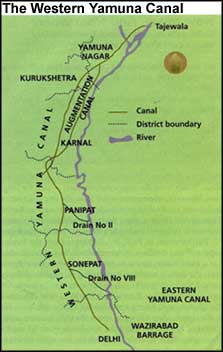Poison river
 This article began with a very simple thought. The Centre for Science and Environment’s (cse) campaigner on sustainable water management, Himanshu Thakkar, had prepared a draft paper on urban drinking water in which he had reviewed a number of documents and newsclippings that the Centre’s library had gathered on the subject. As I read through the draft, I found document after document lamenting the fact that people did not have adequate water and that massive investments would have to be made to ensure the availability of enough water for drinking and other domestic needs. But the literature contained little reference to ‘clean water’; and this reference pointed essentially to bacteriological contamination of water. There was almost no reference to the chemical contamination of our water sources, especially with growing industrialisation and use of chemicals in modern agriculture.
This article began with a very simple thought. The Centre for Science and Environment’s (cse) campaigner on sustainable water management, Himanshu Thakkar, had prepared a draft paper on urban drinking water in which he had reviewed a number of documents and newsclippings that the Centre’s library had gathered on the subject. As I read through the draft, I found document after document lamenting the fact that people did not have adequate water and that massive investments would have to be made to ensure the availability of enough water for drinking and other domestic needs. But the literature contained little reference to ‘clean water’; and this reference pointed essentially to bacteriological contamination of water. There was almost no reference to the chemical contamination of our water sources, especially with growing industrialisation and use of chemicals in modern agriculture.
I wondered whether this was another one of those ‘untold stories’ which nobody cares to investigate and bring to the attention of the public. Suddenly, I came across a news item which described the woes of the people of Agra who suffer from pollution of the Yamuna river by India’s capital city, Delhi. If Agra was suffering because of Delhi, was Delhi suffering because of the industrial and agricultural activities in the upstream state of Haryana? Haryana, as we all know, is a major Green Revolution state, using massive quantities of pesticides. Besides, industrial growth has also been taking place in the state with very little pollution control. Where are all these agricultural chemicals and industrial toxins ending up? The answer was obvious: in the Yamuna, which brings drinking water to Delhi. Something was very wrong here; we were deeply ignorant about a critical issue that literally affects our daily lives.
Since Himanshu was involved in our work on traditional water harvesting systems, I decided to ask Down To Earth reporters Max Martin and Rajat Banerji to find out the level of chemical contamination of the Yamuna; whether this contamination was being removed before drinking water was supplied to the people of Delhi; and, what was happening to the people of Agra. Rajat took the responsibility of following the river down till Delhi, and Max was to follow the river from Delhi to Agra.
Today, when science has made so much progress and almost nothing is beyond human reach, the biggest cause of death is ignorance. What Rajat and Max found
Related Content
- Order of the National Green Tribunal regarding fish sold in Assam contaminated with formaldehyde, 10/04/2024
- Order of the National Green Tribunal regarding pollution of Shillong rivers, Meghalaya, 28/04/2022
- Order of the Madras High Court regarding pollution of river Amaravati, Tamil Nadu, 20/04/2021
- Preliminary report on oil well blowout and explosion at an OIL well in Baghjan, Tinsukia, Assam, 24/07/2020
- Malaysia: schools closed after hundreds poisoned by toxic waste dumped in river
- Order of the National Green Tribunal regarding impact of steel pickling industries on the air quality and on river Yamuna, Delhi, 07/02/2019
